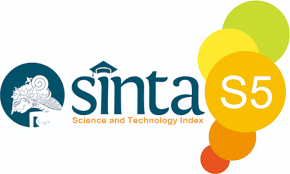Optimalisasi Data Tidak Seimbang Pada Data Nasabah Koperasi dalam Pemberian Pinjaman Menggunakan Random Oversampling
Abstract
Keywords
Full Text:
PDFReferences
A. B. Nugraha, “Perbedaan Saham dan Sertifikat Modal Koperasi Ditinjau Dari Kajian Yuridis Menurut Hukum Koperasi Indonesia,” J. Ilmu Sos. dan Pendidik., vol. 5, no. 4, pp. 2598–9944, 2021, doi: 10.36312/jisip.v5i4.2599/http.
I. G. T. Isa and G. P. Hartawan, “Perancangan Aplikasi Koperasi Simpan Pinjam Berbasis Web (Studi,” J. Ilm. Ilmu Ekon., vol. 5, no. 10, pp. 139–151, 2017.
E. Supriyanto and N. Ismawati, “Sistem Informasi Fintech Pinjaman Online Berbasis,” J. Sist. Informasi, Tekhnologi Inf. dan Komput., vol. 9, no. 2, pp. 100–107, 2019.
A. Sucipto, “Prediksi Kredit Macet Melalui Perilaku Nasabah Pada Koperasi Simpan Pinjam Dengan Menggunakan Metode Alogaritma Klasifikasi C4.5,” J. DISPROTEK, vol. 6, no. 1, pp. 75–87, 2015.
D. P. Utomo and M. Mesran, “Analisis Komparasi Metode Klasifikasi Data Mining dan Reduksi Atribut Pada Data Set Penyakit Jantung,” J. Media Inform. Budidarma, vol. 4, no. 2, p. 437, 2020, doi: 10.30865/mib.v4i2.2080.
Dr. T. Senthil Kumar, “Data Mining Based Marketing Decision Support System Using Hybrid Machine Learning Algorithm,” J. Artif. Intell. Capsul. Networks, vol. 2, no. 3, pp. 185–193, 2020, doi: 10.36548//jaicn.2020.3.006.
S. Al Syahdan and A. Sindar, “Data Mining Penjualan Produk Dengan Metode Apriori Pada Indomaret Galang Kota,” J. Nas. Komputasi dan Teknol. Inf., vol. 1, no. 2, 2018, doi: 10.32672/jnkti.v1i2.771.
D. Hartama, A. Perdana Windarto, and A. Wanto, “The Application of Data Mining in Determining Patterns of Interest of High School Graduates,” J. Phys. Conf. Ser., vol. 1339, no. 1, 2019, doi: 10.1088/1742-6596/1339/1/012042.
H. Annur, “Klasifikasi Masyarakat Miskin Menggunakan Metode Naive Bayes,” Ilk. J. Ilm., vol. 10, no. 2, pp. 160–165, 2018, doi: 10.33096/ilkom.v10i2.303.160-165.
K. Shah, H. Patel, D. Sanghvi, and M. Shah, “A Comparative Analysis of Logistic Regression, Random Forest and KNN Models for the Text Classification,” Augment. Hum. Res., vol. 5, no. 1, 2020, doi: 10.1007/s41133-020-00032-0.
L. Cheng, X. Chen, J. De Vos, X. Lai, and F. Witlox, “Applying a random forest method approach to model travel mode choice behavior,” Travel Behav. Soc., vol. 14, no. August 2018, pp. 1–10, 2019, doi: 10.1016/j.tbs.2018.09.002.
V. Anestiviya, A. Ferico, and O. Pasaribu, “Analisis Pola Menggunakan Metode C4.5 Untuk Peminatan Jurusan Siswa Berdasarkan Kurikulum (Studi Kasus : Sman 1 Natar),” J. Teknol. dan Sist. Inf., vol. 2, no. 1, pp. 80–85, 2021, [Online]. Available: http://jim.teknokrat.ac.id/index.php/JTSI.
H. Sabijono, V. Ilat, and Y. N. Makaombohe, “Rasio Likuiditas Dan Jumlah Kredit Terhadap Profitabilitas Perbankan Di Bursa Efek Indonesia,” J. Ris. Ekon. Manajemen, Bisnis dan Akunt., vol. 2, no. 1, pp. 617–626, 2014.
DOI: http://dx.doi.org/10.22441/format.2023.v12.i1.004
Refbacks
- There are currently no refbacks.
Copyright (c) 2023 Format : Jurnal Ilmiah Teknik Informatika

This work is licensed under a Creative Commons Attribution-NonCommercial-NoDerivatives 4.0 International License.
Format : Jurnal Ilmiah Teknik Informatika
Fakultas Ilmu Komputer Universitas Mercu Buana
Jl. Raya Meruya Selatan, Kembangan, Jakarta 11650
Tlp./Fax: +62215840816
http://publikasi.mercubuana.ac.id/index.php/format

|

Ciptaan disebarluaskan di bawah Lisensi Creative Commons Atribusi-NonKomersial 4.0 Internasional.











